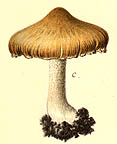 Key to Gilled Mushrooms Key
Key to Gilled Mushrooms KeyThis is a key to gilled mushrooms, that is, mushrooms having a definite cap with a fertile surface consisting of gills. The fruiting body usually also has a stem, although that may be lateral or absent (usually, then, the mushroom is growing from wood). You can use this key to identify mushrooms that you find.
 Agaricales Order
Agaricales OrderFruiting body containing fibers (usually in the stalk)
 Brown, Olive, Orange or Tan Spored Suborder
Brown, Olive, Orange or Tan Spored SuborderGills not free
Spore print tan, orange, deep ochre, yellowish olive, olive brown, rusty or cinnamon brown or deep brown
Ring usually either absent or not membranous
 Lignicolous Brown Spored Family
Lignicolous Brown Spored FamilyGrowing on wood
 Medium To Big Lignicolous Brown Spored Subfamily
Medium To Big Lignicolous Brown Spored SubfamilyCap usually more than 2" across, and sometimes up to 8; usually tan, yellow, or pumpkin-colored
 Pholiota Genus
Pholiota GenusHaving more than one of the following characters:
Cap slimy (all slimy MediumToBigLignicolousBrownSpored mushrooms go here)
Cap covered with pointy or fibrillose scales (all MediumToBigLignicolousBrownSpored mushrooms with this sort of scales go here)
Cap often yellowish
Smooth Pholiota Section

Diagnosis
- Growing on wood
-
Neither cap nor stem scaly; perhaps with just a few scattered flakes or patches
-
Not as likely to be yellow as the Scaly Pholiotas
Narrow down your identification:
Greenish Pholiota SubSection- Cap up to 2 1/2" across; slimy; olive brown at first, becoming browner at the disk and yellow to greenish yellow towards the margin
-
Flesh yellow to greenish yellow
-
Gills sometimes notched, yellow or greenish yellow at first
Pholiota astragalinaCap up to 2" across; pink to apricot; slimy when fresh; discoloring blackish in places
Gills emarginate; orange or yellow; bruising brownish
Partial veil yellow, sometimes leaving fragments on cap margin
On coniferous wood
Pholiota lentaCap up to 4" across; white or pale pinkish tan, perhaps with grey tints; slimy to viscid; with a few small white cottony patches of universal veil material
Gills sometimes subdecurrent; sometimes appearing finely fringed from cheilocystidia
Partial veil a thick but evanescent cortina, sometimes leaving an annular zone on the stalk
In woody soil or humus
 Pholiota veris
Pholiota verisCap up to 2 1/4" across; brown to tan, with cinnamon tones at first; clearly hygrophanous
Partial veil yellowish cinnamon, leaving a thin membranous ring on the stalk
Our collection had white rhizomorphs, not noted in the literature
On well-decayed deciduous wood or woody debris






 Key to Gilled Mushrooms Key
Key to Gilled Mushrooms Key Agaricales Order
Agaricales Order Brown, Olive, Orange or Tan Spored Suborder
Brown, Olive, Orange or Tan Spored Suborder Medium To Big Lignicolous Brown Spored Subfamily
Medium To Big Lignicolous Brown Spored Subfamily Pholiota Genus
Pholiota Genus
 Pholiota veris
Pholiota veris




